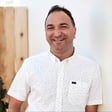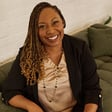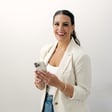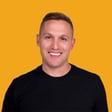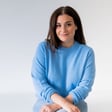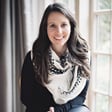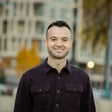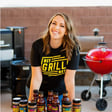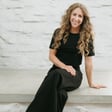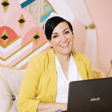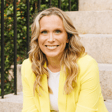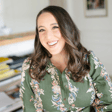Engaging Your Audience
00:00:05
Speaker
Let them know why they need to watch this. Make them hit that pain point that they're having and let them know you're going to solve it in that first 15 seconds. So it may be something like if you're thinking about starting a YouTube channel in 2019 and you have no idea where to get started, stick around because I'm giving you 10 easy steps to get started this weekend.
Meet the Host and Guest
00:00:29
Speaker
Welcome to the Brands at Book Show, where we help creative, service-based businesses build their brands and find more clients. I'm your host, Davy Jones.
00:00:41
Speaker
Today's guest is YouTube strategist Trina Little. And as you've probably guessed, we're chatting about how to utilize YouTube in your business. I heard about Trina from a mutual friend, but I got the opportunity to meet her in person at a conference we recently spoke at. And I'm glad I did because she knows her stuff. This is one of those episodes where you'll want to have the notepad ready.
00:01:00
Speaker
Trina is an MBA graduate who has built two YouTube channels of her own, and she's served clients like Heather Crabtree, Thinkplate Creative Collective, The Contract Shop, and Jessica Rastell. And she also speaks at various conferences about YouTube strategy. You'll want to check out the show notes at davemanchrista.com for the resources we mentioned during this episode. Trina provides a number of freebies to help people get their YouTube channels started.
00:01:22
Speaker
And I'd like to hear from you about what kind of content you'd like to see on the Brancetbook podcast as we move forward. I'd also like to know what episodes you've enjoyed most so far and why.
Listener Feedback and Initial Struggles
00:01:31
Speaker
To leave your feedback, head on over to the Davey and Krista Facebook page and send us a message. Now, on to the episode.
00:01:44
Speaker
Well, I'm super excited to have you on the show today, Trina. YouTube is something that we've been playing around with. Even beginning when we started this podcast, we had started a corresponding YouTube channel for it as well, and it went down in flames. No, I wouldn't say that.
00:02:00
Speaker
What I would say is that we have far more listeners on iTunes and other podcast players for this than we do a YouTube channel. And then maybe that has to do with how people consume this kind of long form material. But I'm excited to dig into all of that with you today. And I've heard so many good things about you from mutual friends like Vanessa Kynes, who was on the podcast earlier this year.
Trina's YouTube Journey
00:02:22
Speaker
And video is just something that I would like to do more with. So there's so much to talk about today.
00:02:29
Speaker
Yeah, I can imagine. From video to YouTube to everything in between. Yeah, so I'm excited to hear about your story about how you got started with YouTube, just the little that I know about you. And we got to meet each other at Creative at Heart this year, but didn't have a chance really to chat all that much. How did you get into YouTube? I know that it was sort of like a roundabout way, right?
00:02:49
Speaker
Yeah, so there's no real YouTube major in college. And I don't want to date myself, but I graduated college before YouTube was even a thing. And so when I was going through my master's in business, like we didn't even have any of that stuff. And so
00:03:07
Speaker
I had my job out of college. I pretty much was bored to death. It was no fun at all. And when I got pregnant with my first child, I was the first one in the group of friends to get pregnant, so I didn't really know what was going on, what to expect. And I somehow stumbled upon YouTube and started watching mostly mom bloggers talking about their pregnancy updates. I found somebody who was a month ahead of me, so I started watching her updates.
00:03:34
Speaker
And then my business brain clicked with my creative brain and thought, I would literally buy anything that she told me to buy right now. Everything she talked about in her baby registry, I was adding it to my list and I was wondering why weren't more businesses doing this?
00:03:49
Speaker
And so I just decided to start my own YouTube channel and started creating a community and realize how instant the connection is on video, because it's kind of like you're speaking to somebody, you see them, it's like they're there with you. And then people started asking me how I did certain things on YouTube.
00:04:05
Speaker
It's just snowballed from there. I convinced my husband with a lot of promises that if I quit my job, I would make this work. I officially left my job at the end of 2015 when my daughter was 10 months old and jumped head first at the beginning of 2016 and threw ups and downs in roller coasters of entrepreneur life. I'm still doing it.
00:04:29
Speaker
Well, so what were you doing prior to YouTube? Yeah, I worked for the federal government. There's an army base here in our town and I worked there doing kind of human resources stuff, but not really but kind of and it just was not my jam. It was not something that
00:04:48
Speaker
made me excited. When we would go on trips, when we would vacation, I was the person taking all the video and then splicing it all together and editing it. So all of our friends that were across the country, we could share that with them on a YouTube video so we could all remember our vacations together. And so I loved video editing. So that's kind of how it tied into YouTube and starting my own business.
00:05:10
Speaker
Yeah, so that's kind of crazy though because you just had a 10-month-old at the time. And I always talk with Chris that we just had our first Jack who is about six months, almost exactly six months now. And one of the things that I was talking about with her recently was would we have taken the same risks
00:05:27
Speaker
had we had Jack earlier on in our marriage because we were married for eight years before she got pregnant when it's just the two of you, right? It's a little bit easier to wrap your mind around, you know, taking some risks. But with a 10-month-old, I mean, so how did that conversation go over with your husband? And were you confident that this YouTube thing was going to take off?
00:05:47
Speaker
I was confident. My husband is skeptical because he's a finance person. But while I was off on maternity leave, there was like some issues taking maternity leave and going back. It just wasn't good. And so he saw how it was going to affect me if I kept going back to work. So that's kind of where it went. And I don't want to surprise you even more. But with the 10 month old and the first year of business, we found out we were pregnant with the second child five months into business. So it was really crazy.
00:06:17
Speaker
Yeah, I guess probably a hard lesson in productivity or making the most I mean, that's been one of the biggest adjustments is I was so naive, I hesitate you to even say this out loud. But like, you know, when Krista got pregnant, and we were thinking about what life would be after having a child, I was just thinking, you know, in the beginning, they just
00:06:34
Speaker
They sleep, they eat, and they have a little bit of awake time, and that's it. Life would pretty much look similar to how it does now. Chris and I were always pretty disciplined people, but life has changed in so many ways. I was very, very wrong about that. That is crazy. How did you first start getting clients with this new company as a YouTube strategist?
Building Authority and Trust
00:06:57
Speaker
Yeah, so a lot of people that were watching my mom videos started asking me questions and then I just started to find this creative entrepreneurial niche or community and Facebook groups. Since people, I branched off of my mom YouTube channel and started a business channel where I talked about how to get started with equipment and like basics of YouTube channels.
00:07:16
Speaker
And people started talking about me in Facebook groups because I became the authority figure so quickly because I was on video. I really attested to being on video. People were able to connect from me, learn quicker from me. And so anytime people would ask a video question or a YouTube question in about five or six Facebook groups that I was in, everyone was always tagging me. And so it was pretty easy to just
00:07:39
Speaker
Once the people started rolling in, it was pretty easy to make it doable with clients from there because they felt like they knew me after watching a video and they could know right away whether they wanted to work with me or not. Yeah, I think this is probably a good transition into what the maybe the advantages or benefits of YouTube are. I mean, would you say that that's one of the biggest benefits of being on video is just it's more instant trust?
00:08:05
Speaker
huge. Yeah, I mean, not only me, but quite a few of my clients, they're finding their qualified leads for people that actually buy are coming from their YouTube videos. Because I mean, obviously, we are not going to be somebody for everybody. We have an audience and we know that we're going to connect with that audience. And so being on video allows you really to skip that step of weeding out people that aren't right for you.
00:08:29
Speaker
and instantly connect with that person that's going to purchase your package or your services or whatever it is that you're selling. So when somebody gets on YouTube, is that kind of the main benefit is building trust with your audience? I'm sure there's other benefits to being on YouTube as well. But what expectations should people have from things like advertising income? There's obviously channels out there, would that get
00:08:53
Speaker
their videos get maybe millions of views. And I assume that they make decent advertising revenue from those videos. But for the large majority of people getting on YouTube, what should their expectations be around the benefits of being on YouTube? Yeah, I actually teach not to just focus on AdSense. As your income, you should always have a business model off of YouTube because AdSense are not guaranteed. In the past two years, there's been what people refer to as adpocalypse. And so you can't always count on the ads.
00:09:21
Speaker
I mean, my channel is small, it's under 10K, but it brings me enough qualified leads that have a full-time business. And as far as AdSense money that I'm getting per month is maybe $100 a month. And so it's nothing that I bank on. I use that video to really build my trust with people. I use those videos also now in newsletters and in funnels.
Monetization Strategies
00:09:44
Speaker
And so that as people come in through an opt-in, if they don't know, I have a YouTube channel because I also
00:09:49
Speaker
have a Pinterest strategy and I show up in Google results, they are able to get to know me more through video with video that I've already done in my funnels when I link to videos. And so for YouTube, especially it being a video search engine and obviously owned by Google as well, do you have you found increased search visibility through Google search results?
00:10:10
Speaker
Yeah, actually, it used to be Pinterest was my number one external traffic source, but now it's Google. And what's amazing with that is on a Google front page in a search term, not only could you have a YouTube video show up, which Google is always going to put the YouTube video towards the top of the page because Google values video. But if you embed it into a blog post, I have multiple keywords where I have not only my YouTube video, but my blog post on the front page search results. So that's two results on the front page.
00:10:39
Speaker
Yeah, that's awesome. And I think what's incredible about that too is that I see Pinterest as a channel with a ton of opportunity even now. I mean, so many people use Pinterest, but I still think there's a lot more or a lot of opportunity there, whereas the search result pages are a little bit crowded. So maybe there's a little bit more competition there. So that's awesome that you're seeing so much referral traffic from Google now.
00:11:02
Speaker
And I've noticed that in the search result pages as well as that the YouTube videos are going to show up right at the top of the pages and they're really going to promote those over something like just a text blog post. So that's fascinating.
Authenticity vs. Perfectionism
00:11:15
Speaker
So as you got started with your YouTube channel, I think one of the holdups for me for YouTube
00:11:21
Speaker
It's just a simple act of recording a video and then being happy with it. And this is coming from somebody like, you know, I speak on stage in front of people. I like that. You know, I like I like talking. Krista would tell you that I very much like talking, right? Hence the hence the podcast. But at the same time, for whatever reason, when I get in front of video,
00:11:38
Speaker
I go to perfectionist mode, you know, and I kind of overanalyze everything from, you know, how I look to how I sound, and then I find myself re-recording and re-recording to the point where I'm just like, you know, screw this, I'm done with it, and then whatever it is doesn't get done. So have you always just been kind of naturally comfortable on video?
00:11:57
Speaker
It's not they've been naturally comfortable. It's just done is better than perfect. And I leave my very first videos up. My mom channel my very first video, the lighting was terrible. I use a DSLR camera that I didn't know how to use. I borrowed it from my mom. It was out of focus. I was
00:12:16
Speaker
a personality too. And so those are absolutely cringe worthy and terrible, but I leave them up because it shows you where you got to start. Like you just got to rip the bandaid off and do it because the only way you get better is doing it over and over and over. And I find that you are your own biggest critic. And so even though you keep filming it over, you think it's terrible. So many people, most people won't even notice anything. For me, like I'm always concerned
00:12:42
Speaker
About I have bottom crooked teeth. And so I was always concerned and wrapped up on that I've never even had a single person mention that in a video again We get into our own heads and we want like this perfect background But people actually connect better with somebody who's more authentic and allows them to just allows you to just be more you I saw a change when I when I first started I tried to be very perfect and speak the words right and shoot and reshoot and I didn't connect
00:13:12
Speaker
And once I just let go and started talking with my hands and started being more me, that's when my channel started taking off. That's when more inquiries came in. That's when the community started to be built is because I let myself get over that perfection and just let myself be on video. Yeah, I've noticed definitely we're recording a bunch of videos right now for one of our courses and
00:13:34
Speaker
I'm finally at a point where I can do things in one or two takes and just get through it. I feel like it was a long process for me to get there, but at the end of the day, it was just a matter of doing it over and over and over again and keeping with it. With that said, I'd still love to get that YouTube channel going, the way that I envision it going. It might be a good time to talk about equipment. What kind of equipment do you need to get started with a YouTube channel?
Video Creation Essentials
00:14:03
Speaker
Yeah, so I mean, the phones right now have great quality cameras. And so that's a great place to start. One thing that I would do it to invest in first would be lighting. Also, these webcams, a lot of webcams are perfect for YouTube, too. You can record them on your your laptop or whatever you're using. But lighting is kind of the key as photographers, you know, lighting is going to make or break your shot or the quality of the camera. And so one of the easiest things to do is
00:14:30
Speaker
get on Amazon or go to Lowe's and buy daylight balanced light bulbs and just stick them in lights like lamps and get them close to you. And that's the cheapest way to get better lighting. With a phone, I say to get there's a road lavalier mic that's under $100. That's a great way to improve your audio quality. Not only if you're shooting video for YouTube, but again, if you're going to go live on Facebook or on Instagram, you instantly have a better audio quality with a microphone that plugs into your phone. And that's
00:15:00
Speaker
I mean, that's an investment of maybe under $150 with the lighting and a microphone using your phone. And so we get wrapped up in all this equipment. And if you buy all this equipment and you worry about having to set it up every single time, you're not going to do it. So my best advice to people is just start with something simple to just start going.
00:15:20
Speaker
Sure. It's crazy. I have an external video camera for the computer here. It's like a Logitech one. It might have been $100. This Yeti mic that I use for podcasting, maybe $100. Not super expensive to get started, but like you said, if you have a phone, and most everyone does now, and it's probably an iPhone or an Android equivalent.
00:15:42
Speaker
the video you can get out of those things is crazy good. So what about like editing the video? What does that workflow look like for you? How much time should people be spending on editing? And again, going back to the struggles I had initially was, you know, I wanted to edit and make it absolutely look, you know, perfect. And I never got there. And so it never got, you know, it never got released.
00:16:03
Speaker
Yeah, so actually when you're doing a YouTube video, there's a process that goes in place prior to you even start filming. So knowing what the title of your video is and kind of scripting it out so that you can follow the proper format that works well on YouTube. And so by scripting it and knowing exactly what you're going to say, I don't mean you have to read the script word for word, but you know where the video is going. That's going to save you so much time in editing because it's not just you sitting in front of the camera rambling and you're trying to pick like the best pieces of it.
00:16:32
Speaker
I actually tell people when they do script it out just remember a couple lines at a time and take a break and then read the next couple lines like take a breather and then it'll be a lot easier to cut and splice it all together because jump cuts are great to keep people's attention on videos so instead of just doing one big take of you talking everything out just do a couple sentences at a time which makes shooting easier editing easier
00:16:58
Speaker
I use Spinal Cut Pro and there are a bunch of different places out there that you can buy plugins. And I have some editing plugins that have texts, certain type of texts that you may see or color overlays or transitions, even color grading plugins as well. So that makes me editing really easy. But the goal to make editing easy is really have your video planned in advance. So it's taking you less time to shoot it and a lot less time to edit it.
00:17:27
Speaker
So I want to talk to you in a second about planning your video. Something you mentioned though were jump cuts as something to keep people's attention. For people who aren't familiar with YouTube or video, what is a jump cut?
00:17:39
Speaker
So jump cut is where you cut the video and then add the next video. So let's say I'd be talking right now, and then we jump right into the next section without me even pausing. So that just keeps people engaged. Because there's a study out there now that humans' audience retention is like seven seconds now. It's around a goldfish's attention. So having those jump cuts just keeps the eye engaged and minimizes those pauses that people might get bored over.
00:18:07
Speaker
Okay, so interesting and also so sad that our attention is around the same attention span as a goldfish is. But let's go back to talking about planning a YouTube video. What does that process look like? Are you thinking keywords, things like that beforehand? Is that what goes into planning?
Content Strategy for Growth
00:18:24
Speaker
Yeah, so there's a lot that goes into YouTube, but what YouTube is really looking for with a video is actually audience retention. And so kind of the little golden number we look for in videos to see channels start to take off is if you can get 50% of people who click on your video to watch to the end consistently,
00:18:43
Speaker
That's when YouTube is going to start suggesting your videos more. And when YouTube suggests your videos more, those videos get more watch time than if you would show up in search and like say rank your videos in search. The ranking videos usually get less watch time than suggested videos from YouTube. And so that's why it's really important to plan your content out in advance to make sure it's valuable and what your audience wants to see.
00:19:08
Speaker
So what I basically do is I just go to YouTube and I use YouTube search. Sometimes I'll go into the Google incognito window so that YouTube doesn't know my previous search history because YouTube wants me to watch as much video as possible. They're going to put videos in front of me that they think I'm going to watch.
00:19:25
Speaker
And so my search results are gonna be a little skewed just going into my YouTube account and searching. So I'll go into an incognito window and just start typing in the idea I'm thinking in YouTube search, and it's gonna try to pre-populate the keywords. And that's what people are actually searching on YouTube for.
00:19:42
Speaker
So that's a goldmine for video ideas. If I just search how to start a YouTube channel, there's probably five different video ideas like how to start a YouTube channel with zero subscribers, how to start a YouTube channel and grow fast. Those are all different video ideas. And those are actual wording and phrases that people are searching on YouTube. And so planning that out in advance really helps you make sure your video will be successful on YouTube.
00:20:08
Speaker
That's so interesting because I mean, it's, it's very similar to the way that I would tell somebody to do keyword research, right? Just if they were writing a blog post or if they were, you know, for search engine optimization, you could go into Google. You could look at, you know, at the bottom of every search results page, there's a list of related searches. That's it. That's sometimes a good way to generate some, some keyword ideas. And then same thing. If you go into Google and you just use the auto populate, but like you said, you're going to want to use the incognito window.
00:20:35
Speaker
And that's when people are checking their own rankings, right? They often don't use the incognito window, but Google knows that who you are, what website is associated with you, so they're just going to deliver your website higher than it otherwise would be. So super fascinating. So a lot of similarities between how you would do planning for just writing a blog post. About planning though, you talk about audience retention.
00:20:58
Speaker
Is it important to even know what video you're going to do next in your content calendar, so to speak, so that you have somewhere to send people either at the end of that video or so that corresponds with other stuff that you're doing? Yes. This is my big strategy on YouTube is to plan in series or playlist.
00:21:17
Speaker
Playlists are huge on YouTube and that's kind of the way you can get people to binge your content, Netflix style. And so when I'm thinking about my strategy, like what my content is coming up, I'm thinking about five to six videos that I can put into a playlist. So for example, I had a client come to me. She wanted to do a video on how to onboard a new client. I said, that's great. Let's make that the playlist and what are the other videos we could put into that so you can get them to have
00:21:46
Speaker
in those first like three videos, so what to put in an onboarding questionnaire, you know, the best client management tool, what are those easy wins you can get to them, then in video four and five, maybe you go a little deeper explaining, you know, your process and like what it looks like so they can connect with you. And then that final video is your sales video, so to speak, not necessarily to sell something.
00:22:09
Speaker
But your goal in that final video is to send them off of YouTube to get your opt-in or to check out your packages. And so that's for a business. That's probably the best strategy is to think in playlists. Your first two to three videos are going to be those discoverable videos and those quick wins that get new people to your channel. And then those next two videos could be those community videos that allow you to show a little more of your personality, doesn't get to know you.
00:22:33
Speaker
then that final video really sends them to where you need them to go off of YouTube because it's so important to minimize the amount of times you send people off YouTube if you want YouTube to suggest more of your content. Sure. That makes so much sense. But do you add – like through those initial videos, would you ever even include something like a mailing list opt-in or a call to action other than going to the next video? Or do you really try to keep people on for two to three videos without sending them off?
00:23:00
Speaker
Yeah, so I do have my opt-in in the description box link, but my goal for every single video for like the first four or five is to watch the next video. If I can prove to YouTube that I'm keeping people watching more of my content, they're gonna suggest it to more people and that's gonna get me more leads. And so if I'm constantly sending people off of YouTube, YouTube's basically gonna bury my content and they're not gonna suggest it to anybody.
00:23:24
Speaker
And so that's why it's pretty important to think of your strategy in advance and think when those sales videos are going to be so that it kind of wraps your content up into a bow and gets people into your list.
00:23:35
Speaker
So when you come up with these series or playlists, do you publish all your content at once? So you come up with these four to six videos or however long the playlist is going to be and then publish them all at once? Or is it like, do you drip them week to week? What does that look like? Yeah, so YouTube wants consistent new content. So I post on Mondays and Wednesdays.
00:23:54
Speaker
And so the first video may be, I will end my video in kind of a generic type format where I'll say, if you want to learn more about how to use YouTube in your business strategy, make sure you click that video that's on your screen right now. And YouTube has end cards that you can add that send them. And for the first one or two videos, I will add the best for viewer option in the end screen because YouTube, again, is going to put the best video that you have that that person is going to watch.
00:24:21
Speaker
And then the rest would be, you know, make sure you watch the rest of this playlist, click the playlist that's on your screen right now. And then you can always go back once you have a full playlist and change those end screens and update them to the playlist if you want.
00:24:35
Speaker
Yeah, and these end screens are the ones you find within like the YouTube editor, right? Like when you upload a video, and they really are easy to use, you know, you really just select them and drag them in and place them where you where you want them to be. So that's interesting hearing how you use those those end cards real quick about the frequency in which you post you post on Mondays and Wednesdays, your business model obviously is very much around YouTube, being a YouTube strategist,
00:24:59
Speaker
What would you recommend is kind of the minimum amount that people could post to YouTube but still get benefit? Would that be once a week? Yeah, I'd say once a week and spend that extra time instead of posting quantities of videos, post quality. So if you're posting one video, really make sure it's hitting that audience retention goal out of the park.
00:25:19
Speaker
Maybe when you post your first couple of videos and you're testing out YouTube, study that analytic, that audience retention graph and figure out where are people leaving. A lot of the time, so what you were probably seeing by posting these podcasts, you were probably seeing a significant drop in audience retention in the first five seconds. I'm going to guess you probably saw about at least 50% or 60% of people left in the first five seconds.
00:25:45
Speaker
people come to YouTube for a specific type of content. Just like if you posted an Instagram photo on Pinterest, or you posted a Pinterest photo, every platform has its own unique type of content. And it's the same if you're taking Facebook Lives over on YouTube. And so what that's going to signal to YouTube is the significant drop off that your content isn't quality content, and they're just going to start burying your content again.
00:26:08
Speaker
Yeah, and for us, one of the things was just the sheer difference in the amount of people who were listening to the podcast via iTunes, Spotify, Overcast, whatever podcast player versus YouTube. How you edit audio and how you edit video are very different. With video, yeah, you can chop it up, but if you chop it up too much, it looks funny, right? Whereas with audio,
00:26:29
Speaker
you have a little bit more flexibility in how you chop it up. So there are a lot of issues there. And there's two things I want to mention here, or I want to stop and talk to you about, but I don't want to get lost in it, so to speak, because I feel like it's one of those things we totally could. Earlier, you had mentioned different plugins for Final Cut Pro. Final Cut Pro is what we use as well. There's so many other things out there that people can use. And if you just have a Mac,
00:26:55
Speaker
I think iMovie is kind of the built-in Mac one. But for Final Cut, would you be willing to share some of the plugins that you use? You don't even have to share them now, but maybe I could get a list from you for the show notes, some of your favorites.
00:27:10
Speaker
Yeah, so I mean, the main one I use is it's called VFX Nut and UT. And I mean, I know there's other ones out there, but that's basically the only one I bought from is VFX Nut. And I mean, they have packages, they have like a YouTuber package that comes with a whole bunch of different types of text plugins that you can have the fancy text instead of just what Final Cut offers.
00:27:32
Speaker
Okay, good to know. And I'll put that in the show notes. I didn't want to I didn't want to forget about that. And I want people to know that, you know, they could go to the show notes to define that. And that that does make your editing a lot easier, because then you once you set up once on one of your videos, so you get the coloring, right, the font, right, the size, right, then it's just copying it from video to video. And so that makes it a lot quicker and easier to get that text. So if you're doing like
00:27:57
Speaker
Step one, and you want to have a solid background with a fancy text come out, then you just have to copy that to the next video.
00:28:02
Speaker
Yeah, that sounds so easy. That's great. The other thing that I want to talk to you about was the length of that your content that your video should be on YouTube. And so again, using the this podcast as an example, our episodes probably, you know, at minimum, they're about 30 minutes, but more than likely they're 45 or an hour. Does that kind of content just not do well on YouTube? Like, are people really looking for shorter videos? Or what's your experience?
00:28:27
Speaker
There is no secret to length of video. I know there has been a myth going around about YouTube videos need to be 10 minutes because that's what YouTube wants. But what YouTube is looking for is that audience retention. Now you do have to balance that with watch time minutes because again the more
00:28:42
Speaker
If you're thinking about YouTube as like a game, you want to accumulate as many coins as possible, right? And so all the minutes you accumulate are your coins that you're accumulating. But then if you get 50% of people to watch to the end, think of that as like a pot of coins. And so that's even more valuable. So you got to kind of balance the length of the video with how long people are watching. So those videos need to be value packed the entire length so that people are watching. And that's when YouTube is going to start putting more of your content out.
00:29:11
Speaker
Okay, so it doesn't necessarily have to be 10 minutes. It could be three to five minutes as long as people are watching and maybe going on to the next video. And then theoretically, it could be 20 plus minutes as long as people are staying tuned in.
00:29:23
Speaker
Yeah, once you start hitting, say you're hitting 60, 70% audience retention on a five minute video, then that's a signal to you. Let's make it a little bit longer and see if we can accumulate more watch time minutes. For me, I'm not really thinking about the time when I'm shooting my videos. I know the content, I know what points I wanna cover. So some of my videos may be three minutes. I think Monday's video was a longer one and it was 12 minutes. And so I'm not really thinking the time going into it. I'm just thinking about the content that I wanna share.
00:29:53
Speaker
All right, and the last thing that I'm going to ask you about, kind of how you record and publish your videos, we're going to talk about optimization here in a little bit, but how much time from start to finish would you say that you spend on a YouTube video? How much time should people account for? I know in the beginning, it's probably going to be a little bit longer, but in general, what does that process look like from start to finish, creating a single YouTube video, including getting it published and shared?
00:30:19
Speaker
Right. So first I would say doing a single YouTube at a single YouTube video at a time is not a good idea. I do it in batches. So I have two kids and I know I have two days a week that are kid free. So what I do is whether the kids are here or not, I plan about three or four hours to research about 12 videos because I'm going to shoot 12 videos in one day and that's three months.
00:30:44
Speaker
three months worth of content. So I take about three to four hours to plan out my content, doing that keyword research, and then scripting. And then when I shoot video, I'm shooting from about 9 a.m. till noon or one, and I'm shooting all 12 of those videos. I had to do my hair and makeup to be on video, and it's not a hair and makeup day every day here. And so I know if I'm doing that, I'm getting as many videos done as possible.
00:31:10
Speaker
So shooting video, it's going to get easier and easier the more you do it. And so if you just, the first one may be a little bit cold and the second one you're getting warmer. So instead of just having a cold video every single time you shoot a video or something comes up and you can't shoot a video that week, it's good to have them in your back pocket. And then I will edit in a batch too, because again, your brain set is in editing mode and you can easily copy and paste all of those presets that you put in and it makes things so much quicker.
00:31:36
Speaker
So I actually suggest that you batch this content and it'll go so much quicker. Yeah, that's great. Yeah, I mean that's what I do with this this podcast. Actually, you know, I have three interviews today because it would just be it'd be too much to try to schedule interviews throughout the entire week and then figure out a time to get those processed and so on. So I think that's excellent advice. I am not as good as you though in terms of planning like three months out.
00:32:00
Speaker
So I think if I can get like a month out, I'm in pretty good shape. But I do want to move into best practices for YouTube. I know you have a number of do's and don'ts for us. So where do you want to start?
Optimizing Thumbnails and Titles
00:32:11
Speaker
We'll go with the do's and then we'll go to the don'ts. And so the first do is you have to really think about your thumbnail also. So I know we start when I talked about how I researched my videos. A lot of the time I'm looking at the thumbnails that people are using and that's the little image that goes with your video. That's
00:32:29
Speaker
May make or break your video whether that thumbnail grabs people's attention or not and the new YouTube analytics It's called the studio beta. They now give you an analytic for your click-through rate And so that kind of helps you determine whether that thumbnail and your title entice people to click because you're gonna see how many impressions your video got versus how many click-throughs and
00:32:52
Speaker
And so what I suggest doing is always taking a video of yourself at least. People connect with humans, people connect with the whites of your eyes. And so I've been testing this a little bit. I've been noticing for more female targeted videos, it helps if your video, if your thumbnail shows more of your personality instead of like a solid background. So I've been doing more thumbnails of me sitting at my desk and I've seen a higher click through rate.
00:33:18
Speaker
Also, more Instagrammy or Pinterest type photos for thumbnails are doing well for female creators or female targeted videos, just because that's our mindset right now, Pinterest, Instagram.
00:33:31
Speaker
And those include your face like you at you said at your desk or something like that. Yeah, just trying to show possibly what you're talking about. So if I'm talking about power sheets or simplified planner, maybe it's me sitting at my desk writing, or maybe it's me showing that planner, just so they can get an idea of what it's about highly saturated, sharp images do well.
00:33:53
Speaker
and also branding your image somehow. So for me, I have a little pink triangle in the bottom left-hand corner. So if they watch one of my videos and then they go over to the suggested videos after they're done watching my video, my thumbnails stand out with that little pink tab on the side that gets them to click to watch another video of mine if they enjoyed the one they want. So making sure you brand it somehow as well. And is there any text overlay on the videos as well, like the title of the video?
00:34:19
Speaker
So you would want to try test some text. If you put text on it, it should not just reiterate the title. It should just pull out, you know, three or four words that really describe what the video was about or something that teases the story or the value that they're going to learn in that video.
00:34:37
Speaker
Okay, really interesting. And to go back to what you were saying earlier about click-through and impressions, an impression would just be somebody seeing that result. Yeah, in search, in suggested, and the home features, those different places.
00:34:51
Speaker
versus the click-through, which would be actually somebody clicking on that result. And I assume that for YouTube, it's similar to how a Google search result would work where – and you can see this information for Google search results in the Google search console, how many times – how many impressions a keyword has or your site has for a keyword versus how many people actually click through. And I'm assuming that click-through rate is going to be
00:35:14
Speaker
one of those factors for ranking. Is that right? Yeah. Okay. Yeah. Again, YouTube's looking at a lot. It's looking at how long people are watching your videos or looking at your session start time and length, like how long you're keeping people on YouTube too. And so it's looking at a bunch of different things. Awesome. So what's the next do?
00:35:33
Speaker
Then the next two is titles. We always think of titles last. I know a lot of people think of titles last. I would know your title before you even write your content. Knowing your title is really going to help you craft your video to ensure when people click on your video, that's what they're going to see. A lot of times that causes the drop off in audience retention is because you created this title and you thought it was an awesome title.
00:35:56
Speaker
but you crafted it after you did the video and you just kind of fit it in the video box. But if you do the title first, that really helps you craft your content to keep people watching. Because the first five to 15 seconds of your video should be your hook, the way you're gonna entice people and you've got to pull in that title somehow in that first five to 15 seconds to ensure people the video that they clicked on is the video they're actually going to be watching and the value they're going to be getting.
00:36:24
Speaker
Okay, awesome. I don't want to jump ahead if you have a do around hooks. Okay, sure. I can do a hook. Yeah. Is that because I was just wondering what a hook like what does a hook look like? What are you basically teasing content and then going to the the brunt? What does that look like?
00:36:39
Speaker
Yeah, so it's basically the first 15 seconds of your video and a lot of people may open the video saying, Hey guys, it's Trina. Welcome to my channel. But what you want to do is kind of, you know, turn the knife a little bit and let them know why they need to watch this. Make them hit that pain point that they're having and let them know you're going to solve it in that first 15 seconds.
00:36:59
Speaker
So it may be something like if you're thinking about starting a YouTube channel in 2019 and you have no idea where to get started, stick around because I'm giving you 10 easy steps to get started this weekend. So they know they're getting 10 easy steps, they know they're gonna be able to get started this weekend, and they have that pain point. They wanna start a YouTube channel, but they have no idea where to get started. So being able to incorporate all of that into that first 15 seconds will increase your audience retention and will get people watching your video longer.
00:37:28
Speaker
Okay, that's awesome. And would you include any like intro to your channel after the hook? So do you basically the hook and then kind of the introduction like your typical, Hey, I'm Trina and and this is my chat. Yeah.
00:37:41
Speaker
So the next, I'll just flow into the next do and it's a YouTube video format. So the YouTube video format looks like this. You have your hook and then you have a branded intro if you do or don't. So like the graphic or the music or whatever, and that should be max three seconds, three seconds, that's it.
00:37:58
Speaker
because again, we've got short attention spans and it's going to kind of look like an advertisement to people and they're not going to stick around. They don't care how pretty your logo is, but you just kind of want to reiterate your value proposition of your channel and who you are. So three seconds and then you open it with your personal intro. So hook, branded intro, personal intro, where you say your name and the value proposition of your channel. So for me, I say, hi, I'm Trina. On this channel, I help creative entrepreneurs get on YouTube to grow their business. Very to the point
00:38:27
Speaker
Because by 30 seconds, you've got to get to that content, especially people who are brand new to your channel. They don't care who we are. They have that pain point that caused them to click on that video. You've got to get to the content and then you have your content and then you wrap up with your call to action, which is different per video. Awesome. I love your introduction because it is very clear. That value proposition is very clear and right away you understand what it is that you're offering people in general. Do you have any more do's for us or are we jumping into don'ts?
00:38:57
Speaker
Yeah, I think that's a good enough dues I'm gonna start like fire hosing people with all this information and they're gonna be like where do I begin? So let's just do some don't
00:39:07
Speaker
So my biggest don't and my biggest pet peeve I mentioned it a little bit is taking your live videos and putting on YouTube.
Platform-Specific Content Strategies
00:39:14
Speaker
Just because YouTube, people are on YouTube for a different reason and for a different experience. You can use YouTube live, which is a great way, a great piece to incorporate into your content strategy. But one thing that you want to do with your YouTube live thumbnails is have somewhere on there that it's a live video. So whether you have like a little red record button that says live,
00:39:35
Speaker
just so people know going into it when they click on that video, it is a replay of a live video. But again, Facebook videos are totally different because you want to engage with people and talk with people. And so they just they don't work. I've tried it with clients. They don't work. So don't don't do Facebook lives on YouTube. You can put them on unlisted and use them on your website if you want. That way they're not going out to your whole YouTube channel and your whole YouTube universe if you do it unlisted.
00:40:05
Speaker
So basically, that's a setting that you would choose after you upload the video. Correct. And then that way you can embed it wherever you want, but it's not taken away from, you know, both the value that you offer on your on your channel, and then also probably aesthetically, too. Yeah.
00:40:20
Speaker
Okay. Awesome. The other big don't I have is don't try to be something for everyone. So a lot of the times I get people that come to me and they're like, well, I don't really have a niche. I want to talk about this and this, and it's not going to work. People need to have a reason to subscribe to your channel. So for me, the reason why people subscribe to my channel is because wanting to grow their business. It's very specific.
00:40:41
Speaker
and that's going to cause them to subscribe. If you're doing, you know, you like planning videos and you like cooking videos and you like to talk about your business, people are confused and they don't know why they need to subscribe to your video. So don't try to be a jack of all trades on YouTube. Okay. Awesome. Awesome. And what other don'ts do you have for us?
00:41:00
Speaker
Don't just go into YouTube without a plan. Have a plan, have a content plan. Again, YouTube really loves consistency. And so if you can shoot your videos up front and have videos in your pocket so that you know you can have one live every Tuesday, the more you can incorporate your live posting schedule, like the day your video goes live into your audience, the better it's going to help you grow a YouTube channel because
00:41:25
Speaker
If you guys are uploading a video on Tuesdays at noon, your audiences will be like, great, it's Tuesdays at noon, Davey and Christa have a new video up, I'm gonna grab my lunch and watch their video. And so the more views you get when that video is live in that first 24 hours, the more valuable you are to YouTube, and the more they're gonna suggest more of that video to more people. So that's why it's really important to be consistent and have a game plan going into YouTube.
00:41:49
Speaker
Okay, awesome. I feel like that's definitely a mistake that I've made in the past when it comes to YouTube. I've just gone with like the sheer quantity of like, I'm just going to put up as many tutorials as I can. So I do want to talk about optimization here with you, unless there's something else that you wanted to articulate. That's good. Okay, awesome. So definitely want to talk about optimization here. Before I jump into that, subscribers versus something like retention rate, I'm sure that it all contributes somehow to
00:42:17
Speaker
what videos are shown or just ranking in general, like on Instagram, one might say that it's not so much how many followers you have as it is like the engagement you have with those followers, right? Not to say that not having, generally one follows the other, right? Like if people are engaging with your Instagram account, generally people are going to follow that Instagram account as well. So I assume that it's sort of true with YouTube as well. Like how important is it to build subscribers, but really like how
00:42:45
Speaker
How do you weigh that against some of the other things that you look at when you're looking at the metrics for YouTube? Yeah. I mean, numbers are basically a vanity metric, right? It's not making you money no matter how many subscribers you have. At this point in time, I'm under 10K on my YouTube channel. That's a very small channel for the niche YouTube educators, but it converts. It converts for me.
00:43:08
Speaker
And so I actually focus on getting people to watch more of your videos than to say, subscribe to this video because the more you can get people to watch, the more likely they're probably going to subscribe anyways because they're going to start liking you. And they're like, I want to make sure I get all of her videos. So I'm going to go ahead and subscribe.
00:43:26
Speaker
And so, I mean, it's more so the audience retention. I mean, YouTube really understands how we work. And so they know if people are watching your video to the end, that you have quality content in that video, that channel is going to keep people watching. And so they're going to push more and more your content to more people. And that's ultimately how you're going to build more subscribers.
00:43:47
Speaker
Okay, awesome. And I think that's good to clarify because with any given channel, I think, whether it's email subscribers or whether it's an Instagram account, if you have lots of people following those accounts or subscribed to those accounts, but none of them convert like you say, then it doesn't matter. It's just a vanity metric. So watching how people engage with your content along the way, I think is probably
00:44:12
Speaker
I mean, it's certainly more important for a lot of these other channels that we've talked about on the show. So good to know that it's similar for YouTube as well. So we have a video, we've posted it. What are some of the things that we're going to do to optimize that video so that after we're done sharing about it via our other platforms, that maybe it gets some evergreen traffic?
Maximizing Video Visibility
00:44:32
Speaker
Yeah, so a lot of times people talk about metadata and needing all this special metadata and YouTube's at the point now where it knows what your video is about when you post it. And so as far as adding a title that really proposes the value or pitches the story of your video, having that custom thumbnail
00:44:51
Speaker
writing about a true paragraph summary of that video in the description box using keywords, using your tags, so tags are like keywords in YouTube, just using your tags to describe that video. So if I'm talking about how to grow a YouTube channel,
00:45:06
Speaker
I'm not getting really fancy with these tags. My tags are just how to grow a YouTube channel, grow a YouTube channel, how to start a YouTube channel, grow in a YouTube channel, just those types of tags. A lot of people get hung up on having the perfect metadata, but YouTube nowadays knows what your video is about.
00:45:23
Speaker
Adding cards, so cards is another thing you can add to your video. And when you're just getting started, kind of adding them evenly spaced throughout your video. But once you start getting some metrics back on when people are leaving, based on your audience retention, potentially add a card about five seconds before people start leaving. So you suggest another, it's kind of like suggesting another video to them.
00:45:45
Speaker
such a great hack. Anytime I've just added cards at the end, and there's really no rhyme or reason. Sometimes there's a very clear next step, but oftentimes because like you've told us, we should have a plan and I didn't have a plan. It was just whatever is next. I love how you're using the metrics there to figure out, okay, I'm going to go back and I'm going to add those cards. And those are something you can add. Since that's in the YouTube editor stuff, you don't have to rerecord the video to do that.
00:46:14
Speaker
Yeah. And then the other one is getting them transcribed. So YouTube does have an automatic one, but it's not great. So I use the service Rev.com, R-E-V.com, and they do transcriptions for a dollar a minute. And why I love this is because it links to your YouTube channel. So once you purchase the captions, it takes about an hour or two and you automatically have custom captions on YouTube.
00:46:38
Speaker
And that's going to help your audience retention because a lot of us like to read as we're hearing, as we're watching what they're saying. And so that increases your audience retention, also the deaf community. And you can take that caption that they create, download it and upload it to Facebook if you upload your YouTube video natively to Facebook. So that's kind of how I repurpose. I go from YouTube to Facebook and I upload that YouTube video natively to Facebook and add those captions that I paid for to that Facebook video.
00:47:08
Speaker
You could you also use that almost as a like a blog post, you know, you might go in and change it up a little bit, because how you write is maybe a little different how you speak. But that's interesting. I've seen it's rev. So we've used in the past, Temi, I think that's how you say it, which is, it's the same company, but it's their like, cheap brand, you know,
00:47:25
Speaker
And so it's like 10 cents a minute. So if you're on a budget, that's a good one to check out. The downside though is Rev, I believe they run it through their software, but then I also have humans check it, right? So it comes back with like nearly 100% accuracy, I assume. Whereas Temi, it's basically you're just running it through their software. So you'll have to go back in and make a bunch of updates. But if you're looking to save a couple of dollars, it's a good way to do that and get captions.
00:47:52
Speaker
But they also, they don't have a direct connection, as far as I know, to YouTube, like Rev does. But if you're only doing a six minute video, right? Six minutes a week, yeah. See, I was transcribing these podcasts, which are an hour. So all of a sudden, you're spending $60 just to get it transcribed. Now, I have this service that does it, that edits and all that stuff too as well. But Rev, for something like the podcast, gets a little pricey.
00:48:19
Speaker
But that's awesome. So I got to imagine that people are going to be – first of all, they're going to – I bet people are taking notes. If you're feeling a little overwhelmed, that's okay. Don't let that stop you because I know that you have resources already available via things like Trello that actually break up everything we talked about. So it's all laid out nice and neat. So can you talk about where people can find some of these resources if they want to get started?
00:48:46
Speaker
Yeah, so I have the YouTube roadmap launch. It walks you through 10 steps. It helps you figure out that value proposition and takes you along the steps of setting up your YouTube channel and getting it ready. And that's at my website, trenalittle.com forward slash roadmap. And then if you're really ready to get a workflow in place and you just want to copy, swipe what I have,
00:49:08
Speaker
I have a Trello board that walks you through every single process. I think it's at over 50 checkpoints. So I'm a checklist person. I love being able to check things off a checklist. So it takes you through the research phase. Here are the five checklists you need to do in the research phase. Then you go into the scripting phase. Here's your checklist. Here's your scripting template. So it takes you through every process with all its checklists that you need to do for that process. And that's at Trenalittle.com forward slash workflow.
00:49:37
Speaker
Okay, awesome. And I'm jotting this down real quick. Because you'll be able to, you can, if you go to the show notes for this, this episode, we will have those resources listed out so that you can go directly to Trina's website, download those things, get access to that kind of stuff. And then also find her YouTube channel as well. You know, if you are interested in starting a YouTube channel. And again, I think that there's just so much opportunity there.
00:49:59
Speaker
And it's going to take a little practice getting started, but YouTube, Pinterest, podcasting, I think there's just so much opportunity there because it's not as ubiquitous as blogging. And I'm pro-blogging. I don't think blogging is dead or any nonsense like that.
00:50:16
Speaker
I just think that it's probably easier to cut through the noise in starting a YouTube channel because percentage-wise of business owners, there's probably a 90% chance that a business has a blog, but do they have a YouTube channel? And so it's an extra way I think to get search visibility.
00:50:32
Speaker
Yeah, I don't know what the most recent statistic was, but in 2017, it was like 9% of small businesses were on YouTube. And so I'm not sure what it was this year, but you can kind of cut through the noise like you said a bit on YouTube. Yeah, I mean, but even if that double, like even if it's 20% now, even if it's even if it's a 45% now, you know, I guarantee you that the number is far lower than the people who have a blog.
00:50:54
Speaker
And we could keep talking. I'm going to start wrapping it up here again just for speaking of audience retention and things like that. But anyways, Trina, thank you so much for joining us on the podcast here. I can't wait to implement the things that we talked about. And are there any other places that people can connect with you beyond your website and YouTube channel?
00:51:14
Speaker
Yeah, I do a lot of Instagram stories, so I will share a lot of the times when I'm batch recording. So what that looks like, the stack of clothes I have on the floor that I'm changing into. And so that's at instagram.com, whatever, forward flash, Trina, underscore, little. All right, awesome. Well, thank you so much. Yeah, thank you.
00:51:35
Speaker
Thanks for tuning in to the Brands That Book Show. If you enjoyed this episode, please consider subscribing and leaving a review in iTunes. For show notes and other resources, head on over to devianchrista.com.

